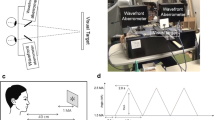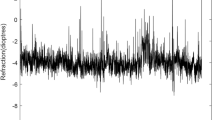Abstract
Purpose
To investigate the serial changes of accommodation and spherical aberration in eyes with accommodative spasm.
Methods
Four patients with accommodative spasm and ten healthy subjects were studied. The ocular refractive power (spherical equivalent) and spherical aberration were measured serially with an open-field, binocular Hartmann–Shack wavefront aberrometer. Patients and subjects wore full-correction lenses and were instructed to fixate a target set at 50 cm from the eye. The time-average of the refractive power, spherical aberration, and fluctuations of accommodation analyzed by the fast Fourier transform (FFT) of the two groups were compared.
Results
The average ± standard deviation refractive power in the patients was significantly more negative than that in the healthy subject (−3.12 ± 1.06 vs. −1.49 ± 0.17 D). The integrated intensity of the FFT from 1 to 4 Hz was significantly higher in the patients than in the healthy subjects. The spherical aberration in patients was more negative than that in the healthy subjects (−0.033 ± 0.048 μm vs. 0.002 ± 0.027 μm).
Conclusions
Eyes with accommodative spasm are characterized by a lead of accommodation with greater fluctuations and negative spherical aberrations. Excessive accommodation can be measured objectively in such eyes with a binocular wavefront aberrometer without cycloplegics.







Similar content being viewed by others
References
Goldstein JH, Schneekloth BB. Spasm of the near reflex: a spectrum of anomalies. Surv Ophthalmol. 1996;40:269–78.
Ninomiya S, Fujikado T, Kuroda T, Maeda N, Tano Y, Hirohara Y, et al. Wavefront analysis in eyes with accommodative spasm. Am J Ophthalmol. 2003;136:1161–3.
Airiani S, Braunstein RE. Accommodative spasm after laser-assisted in situ keratomileusis (LASIK). Am J Ophthalmol. 2006;141:1163–4.
Rutstein RP, Marsh-Tootle W. Acquired unilateral visual loss attributed to an accommodative spasm. Optom Vis Sci. 2001;78:492–5.
Faucher C, De Guise D. Spasm of the near reflex triggered by disruption of normal binocular vision. Optom Vis Sci. 2004;81:178–81.
Kawasaki A, Borruat FX. Spasm of accommodation in a patient with increased intracranial pressure and pineal cyst. Klin Monbl Augenheilkd. 2005;222:241–3.
Kobayashi M, Nakazawa N, Yamaguchi T, Otaki T, Hirohara Y, Mihashi T. Binocular open-view Shack–Hartmann wavefront sensor with consecutive measurements of near triad and spherical aberration. Appl Opt. 2008;47:4619–26.
Campbell FW. Correlation of accommodation between the two eyes. J Opt Soc Am. 1960;50:738.
Okuyama F, Tokoro T, Fujieda M. Binocular infrared optometer for measuring accommodation in both eyes simultaneously in natural-viewing conditions. Appl Opt. 1993;32:4147–54.
Chan PRV, Trobe JD. Aspasm of accommodation associated with closed head trauma. J Neuroophthalmol. 2002;22:15–7.
Iskander DR, Collins MJ, Morelande MR, Zhu M. Analyzing the dynamic wavefront aberrations in the human eye. IEEE Trans Biomed Eng. 2004;51:1969–80.
Collins M, Davis B, Wood J. Microfluctuations of steady-state accommodation and the cardiopulmonary system. Vision Res. 1995;35:2491–502.
Koh S, Maeda N, Hirohara Y, Mihashi T, Ninomiya S, Bessho K, et al. Serial measurements of higher-order aberrations after blinking in normal subjects. Invest Ophthalmol Vis Sci. 2006;47:3318–24.
Charman WN, Heron G. Fluctuations in accommodation: a review. Ophthalmic Physiol Opt. 1988;8:153–64.
Ninomiya S, Fujikado T, Kuroda T, Maeda N, Tano Y, Oshika T, et al. Change of ocular aberration with accommodation. Am J Ophthalmol. 2002;134:924–6.
Acknowledgments
This work was supported by the Grants-in-Aid Scientific Research (No. 19209053) from the Ministry of Education, Culture, Sports, Science and Technology, Japan.
Author information
Authors and Affiliations
Corresponding author
About this article
Cite this article
Kanda, H., Kobayashi, M., Mihashi, T. et al. Serial measurements of accommodation by open-field Hartmann–Shack wavefront aberrometer in eyes with accommodative spasm. Jpn J Ophthalmol 56, 617–623 (2012). https://doi.org/10.1007/s10384-012-0187-7
Received:
Accepted:
Published:
Issue Date:
DOI: https://doi.org/10.1007/s10384-012-0187-7




